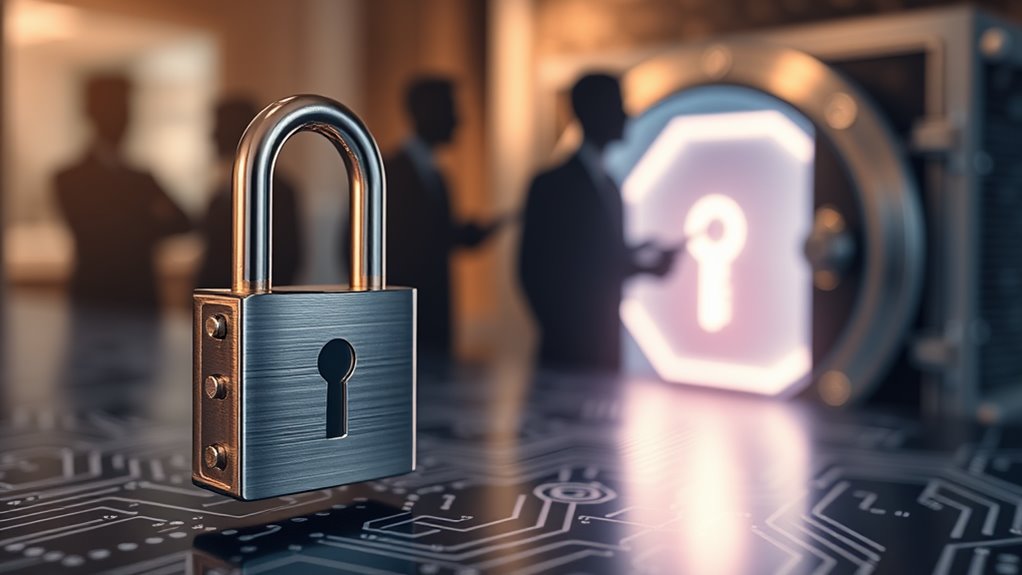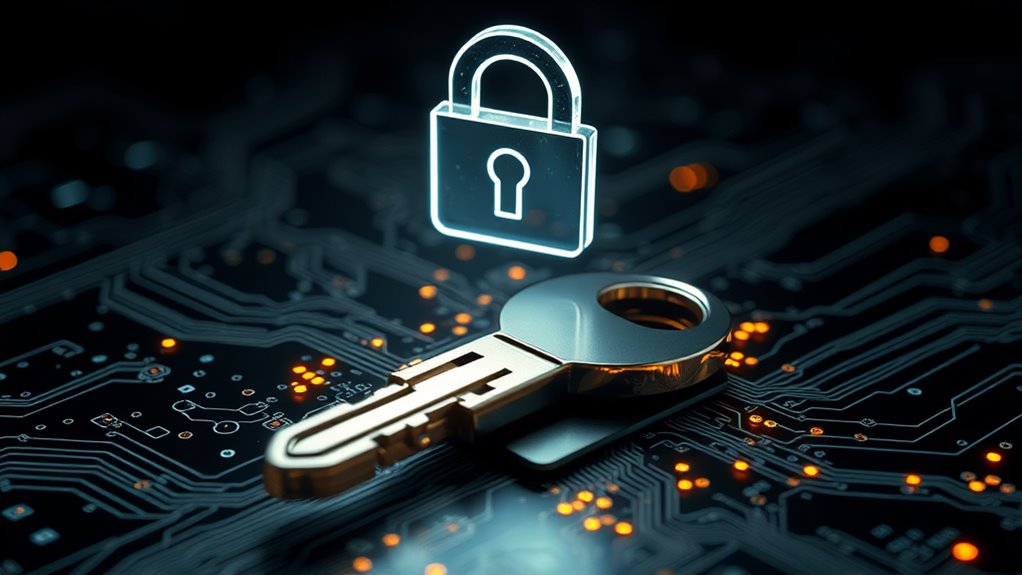
Public and Private Key: The Essentials of Cryptocurrency Security
Public and private keys serve as fundamental security elements in cryptocurrency transactions, functioning like a sophisticated digital lock and key system. The public key acts as a visible address for receiving funds, while the private key provides exclusive access to manage and transfer digital assets. Security measures include hardware wallets, encryption protocols, and multi-signature schemes to protect against threats like phishing and malware. Understanding these cryptographic principles opens the door to secure cryptocurrency management.
Key Takeaways
- Public keys act as visible addresses for receiving cryptocurrency, while private keys authenticate ownership and authorize transactions.
- Private keys must be kept strictly confidential, as anyone possessing them gains complete control over associated cryptocurrency funds.
- Hardware wallets provide superior security by storing private keys offline, protecting them from online threats and hackers.
- Multi-signature wallets require multiple private keys to authorize transactions, adding an extra layer of security against theft.
- Regular backups of private keys and recovery phrases are essential for maintaining access to cryptocurrency if primary access is lost.
Understanding Public-Key Cryptography Fundamentals

While cryptocurrencies have revolutionized digital finance, their security fundamentally relies on public-key cryptography, a sophisticated system of mathematical algorithms that enables secure communication and transactions.
At its core, public-key cryptography operates through pairs of mathematically related keys: a public key for encryption and a private key for decryption. The system's security stems from complex mathematical functions, particularly prime factorization and elliptic curve algorithms, which make it computationally infeasible to derive private keys from public ones.
This framework allows users to share their public keys openly while keeping private keys secure. The technology facilitates essential cryptocurrency functions through digital signatures and secure data transfer, ensuring that only authorized parties can access encrypted information.
Certificate authorities and PKI infrastructure further strengthen the system by validating public key ownership and authenticity. Two-factor authentication adds an extra layer of security for protecting cryptocurrency assets from unauthorized access.
Key Roles in Securing Your Digital Assets

When securing digital assets in cryptocurrency transactions, the interplay between public and private keys forms the cornerstone of a robust security framework. Public keys function as unique identifiers, enabling secure transaction routing and authentication, while private keys serve as the critical authorization tool for accessing and managing funds.
The security system relies on mathematical encryption, where public keys can be freely shared for transaction validation and traceability. Private keys, however, require stringent protection through methods like hardware wallets, encrypted storage, and secure backup systems.
The loss or compromise of private keys can result in permanent asset loss, making proper key management essential. Multi-signature wallets and regular software updates further enhance security, while seed phrases provide a recovery mechanism if primary access is compromised. Two-factor authentication provides an additional layer of protection against unauthorized access to digital wallets and cryptocurrency accounts.
Private Key Management Best Practices

Effective private key management encompasses several vital security layers that work together to protect cryptocurrency assets from unauthorized access and potential theft.
These layers include secure storage solutions, automated management systems, and strict access controls. Hardware wallets and cold storage offer robust protection by keeping private keys offline, while Key Management Systems (KMS) automate essential security processes like key rotation and access monitoring.
Regular security updates and proper key rotation schedules help maintain strong protection against evolving threats. Organizations implement role-based access controls and follow the principle of least privilege to minimize potential security breaches.
When keys reach the end of their lifecycle, proper destruction protocols, including cryptographic erasure and secure disposal of storage media, guarantee that sensitive information remains protected even after decommissioning.
Common Security Threats and Prevention Strategies

The cryptocurrency landscape faces numerous security challenges that require robust prevention strategies to protect digital assets. Common threats include phishing attacks using fake websites and emails to steal credentials, exchange hacks that exploit software vulnerabilities, and malware designed to compromise wallets or mining operations.
Cybercriminals frequently target users through sophisticated methods like homograph attacks and malicious browser extensions.
To combat these threats, users should implement multiple security measures. These include verifying URLs before entering credentials, using hardware wallets for offline storage, enabling two-factor authentication, and maintaining regular software updates.
Additionally, exercising caution with third-party applications, conducting security audits, and creating data backups helps protect against ransomware attacks and unauthorized access. The combination of these strategies markedly enhances cryptocurrency security. Keeping your private keys in cold storage provides an extra layer of protection by maintaining them completely offline and away from potential online threats.
Advanced Protection Methods for Your Crypto Keys

Protecting cryptocurrency private keys demands sophisticated security measures that extend beyond basic digital safeguards.
Hardware solutions like specialized wallets and security modules provide robust offline storage, while advanced cryptographic techniques such as multi-signature schemes and threshold cryptography distribute security responsibilities across multiple parties.
Modern encryption methods, including AES-256 and secure enclaves, work alongside multi-factor authentication and biometric security to create layered protection.
These measures are reinforced by secure network protocols and VPNs that shield transactions from potential interceptors.
Additionally, thorough backup strategies utilizing recovery seeds and hardware wallet backups guarantee users can restore access if primary security measures fail.
The combination of hardware protection, encryption, and backup solutions creates a robust security framework for safeguarding cryptocurrency private keys.
Web-based wallets offer convenient access but require additional security considerations compared to offline storage options.
Frequently Asked Questions
Can Quantum Computing Break Current Public-Key Cryptography Systems?
Yes, quantum computers using Shor's algorithm can break current public-key cryptography systems like RSA and ECC by efficiently solving complex mathematical problems that classical computers find practically impossible to calculate.
How Often Should I Change My Cryptocurrency Wallet's Private Keys?
Unlike traditional passwords, cryptocurrency private keys shouldn't be changed regularly. Changes are only necessary when compromise is suspected, after security breaches, hardware loss, or significant life events affecting key security and access.
What Happens to My Crypto if I Die Without Sharing Keys?
Without shared private keys, cryptocurrency becomes permanently inaccessible upon death. The assets remain frozen in the blockchain, effectively lost forever, joining the estimated 20% of Bitcoin already considered permanently inaccessible due to similar circumstances.
Are Brain Wallets Safer Than Hardware Wallets for Storing Private Keys?
Despite their apparent simplicity, brain wallets expose users to significant risks from brute-force attacks and memory failures. Hardware wallets provide superior security through specialized encryption chips and physical safeguards, making them the safer choice.
Can Lost Private Keys Be Recovered Through Blockchain Forensics?
Lost private keys cannot be recovered through blockchain forensics. While forensics can track transactions and identify fund movements, the mathematical nature of private keys makes them impossible to reconstruct once lost.
Conclusion
Public and private keys function like a digital fortress protecting cryptocurrency assets, where each stone must be carefully placed and maintained. Understanding their fundamental roles, implementing robust security practices, and staying vigilant against evolving threats are essential for safeguarding digital wealth. Through proper education and diligent key management, cryptocurrency holders can considerably reduce their vulnerability to attacks while maintaining secure access to their assets.












